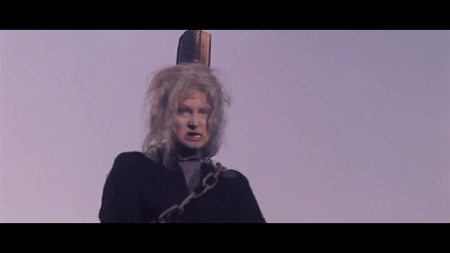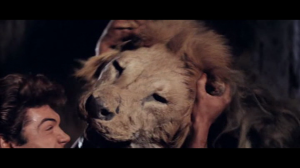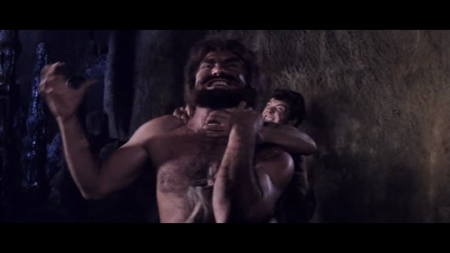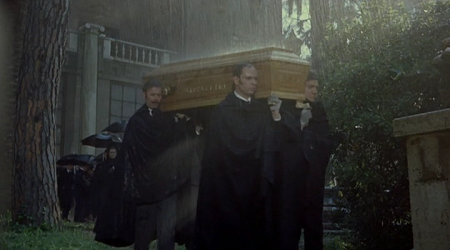Like his Gothic spookfest THE GHOST, Riccardo Freda’s MACISTE IN HELL begins with a witch-burning in Scotland. As is traditional in these affairs (dating back directly to MASK OF SATAN, but beyond that to, I guess, I MARRIED A WITCH) the witch curses the townspeople who are about to immolate her.
A title tells us that a hundred years has passed, and suddenly an outbreak of madness is afflicting the women of “Loch Laird” — no reason why the curse should take a century to come into effect, except that it’s impressive yet inexpensive to say “100 years later” in a film of this kind.
And now Charley Law, a young cavalier, rides up with his betrothed, a descendant of the original witch, planning to honeymoon in the bat-infested ancestral castle. An angry mob of torch-wielding villagers promptly batters down the door using one of the few un-tossed cabers in Scotland, and takes his bride into jolly old custody. It looks like she’s going to become a barbecue like her ancestor —
And then Maciste — former Carthaginian slave in CABIRIA (1914), but since then a fair-skinned righter-of-wrongs in a geographically diverse series of 60s peplums (pepla? what’s the plural here?) — rides up. Nobody questions the abrupt presence of a bodybuilder in a loincloth in 18th century Scotland, they don’t even ask him his name. They just seem to understand. That’s us Scots — an understanding people.
Since we’re in Loch Laird, I’m going to start calling him MacChesty. He’s a sort of naked Lone Ranger figure, and he promptly descends into Hell (located beneath a local cursed tree) to sort things out. This involves MacChesty wrestling a lot of stuffed animals and quizzing Sisyphus and Prometheus, making inquiries, like Columbo in baby oil.
Kirk Morris, in the lead, brings pecs and an Elvis sneer to the part, along with the towering screen magnetism of a polystyrene boulder.
Most of the animal action involves intercutting fake snakes, eagles and lions with the real thing — the live, but very sleepy lion is actually a lioness in drag, adorned with a fake mane. Freda, who is absolute tops in my list of genius-or-idiot? filmmakers, boldly cuts back and forth between Kirk Morris with his frosted highlights earnestly throttling products of the taxidermist’s art in graphic close-up, to longshots where the animals are slightly more animate. Too animate — after MacChesty “kills” the lion, it can be seen contentedly blinking and flapping its ears.
Freda is a filmmaker who loves special effects, but want us to appreciate just how “special” they are, by lingering upon them until their artifice becomes wholly transparent. See also the car crash at the start of A DOPPIA FACCIA, which quite unnecessarily rubs our noses in the substitution of a toy car for the real thing, and even jump-cuts a few tiny explosions in for good measure. “Audacious” doesn’t begin to describe it — and I truly don’t know if Freda is expressing his contempt for the material, or the audience, or a childlike love of magic tricks, or sheer helplessness in the face of a low budget (he began his career with expensive historical epics in the Mussolini era).
But even more thrilling is the fight with Goliath. Goliath laughs at MacChesty, so MacChesty tosses a caber at him. Then we get a great, audiacious, forced-perspective fight between Goliath, a large-ish actor, and some kind of muscular child or jockey doubling for Kirk M.
All the tricks are bold and cunning, and all of them are immediately transparent — my favourite is this one, where Morris stands far enough behind Goliath so he’ll look smaller, and a pair of small plastic hands pretend to throttle the chucklesome titan.
F Scott Fitzgerald said there are no second acts in American lives, but I reckon he was really talking about Italian muscle pics. To pad this one out, we get a montage of Maciste’s greatest hits since 1960, which further develops Freda’s genius for overt, eye-popping juxtapositions, since more of the movies sampled feature different actors playing MacChesty.
The original Maciste, Bartolomeo Pagano, bowed out in 1927. In 1960 the character came back in the form of Mark Forest, who relayed it to a variety of similarly-bulbous he-beings — surely there’s a parallel there with the way German cinema after the war revived characters like Mabuse from its pre-Fascist past, as if to forge a continuity that circumvented the problematic era. At any rate, I’m glad they did, and Freda, the one Italian cineaste who truly rejected neo-realism and everything it stood for, was a natural recruit to the genre.







